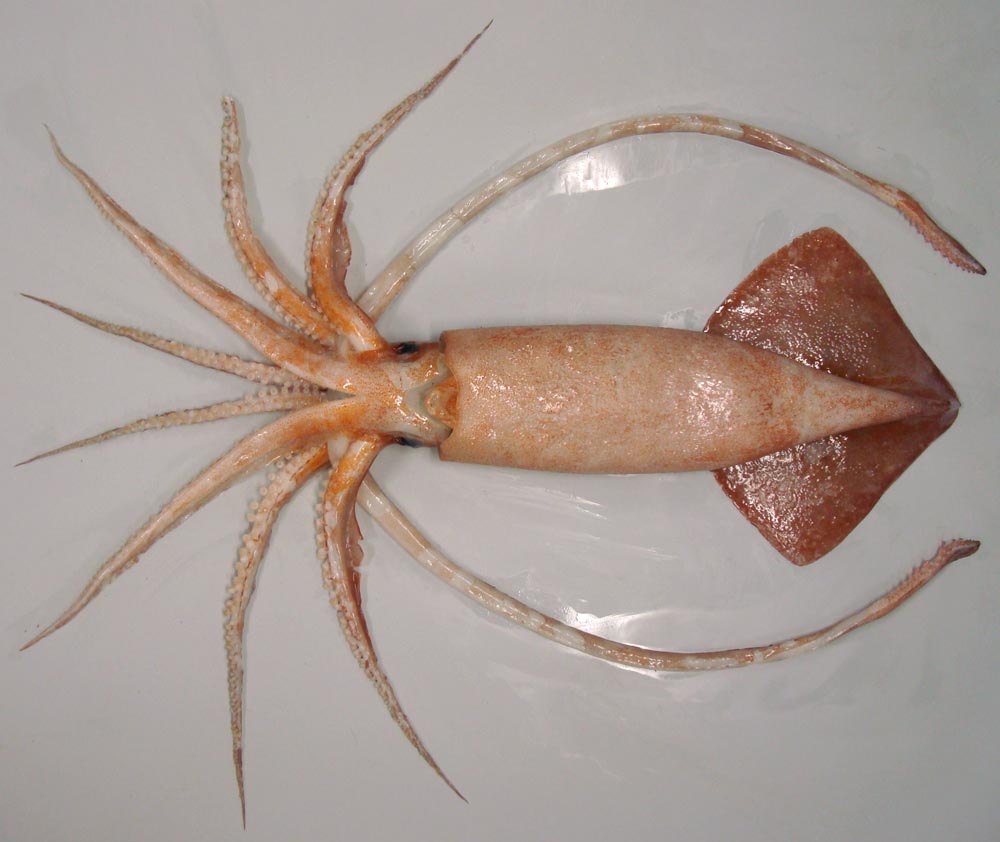Moroteuthis ingens on:
[Wikipedia]
[Google]
[Amazon]
''Onykia ingens'', the greater hooked squid, is a species of
 The size of a fully grown ''O. ingens'', inclusive of tentacles, is currently unknown. Many estimates, however, predict that the
The size of a fully grown ''O. ingens'', inclusive of tentacles, is currently unknown. Many estimates, however, predict that the
CephBase: Predators of ''Moroteuthis ingens''
.
Image:Morotuthis ingens2.jpg, Tentacular club of ''Onykia ingens''
Image:Moroteuthis ingens3.jpg, Piece of ventral mantle skin
Image:Moroteuthis ingens4.jpg, Gladius with cross-sections
Tree of Life web project: Onykia ingensFirst observation of a double tentacle bifurcation in cephalopods
{{Taxonbar, from=Q1950090 Squid Cephalopods described in 1881 Taxa named by Edgar Albert Smith
squid
True squid are molluscs with an elongated soft body, large eyes, eight arms, and two tentacles in the superorder Decapodiformes, though many other molluscs within the broader Neocoleoidea are also called squid despite not strictly fitting t ...
in the family Onychoteuthidae. It occurs worldwide in subantarctic oceans.
Although ''O. ingens'' was long attributed to the genus ''Moroteuthis'', several authors have recently agreed that ''Moroteuthis'' is a junior synonym
The Botanical and Zoological Codes of nomenclature treat the concept of synonymy differently.
* In botanical nomenclature, a synonym is a scientific name that applies to a taxon that (now) goes by a different scientific name. For example, Linna ...
of ''Onykia.''
Size and growth
 The size of a fully grown ''O. ingens'', inclusive of tentacles, is currently unknown. Many estimates, however, predict that the
The size of a fully grown ''O. ingens'', inclusive of tentacles, is currently unknown. Many estimates, however, predict that the mantle
A mantle is a piece of clothing, a type of cloak. Several other meanings are derived from that.
Mantle may refer to:
*Mantle (clothing), a cloak-like garment worn mainly by women as fashionable outerwear
**Mantle (vesture), an Eastern Orthodox ve ...
may reach lengths of up to 94 cm (37 in). Research has found that egg sizes of the squid average 2.1 mm inside mature females, while juveniles average 4.6 mm or larger. Juveniles are presumed to live near the surface, until they reach a mantle length of approximately 200 mm, at which time they relocate to deeper water, and larger prey. ''O. ingens'' exhibit sexual dimorphism, with females growing linearly twice as fast as males, and reaching a fully mature size of more than five times that of male counterparts.
Penis elongation has been observed in this species; when erect, the penis may be as long as the mantle, head and arms combined.Arkhipkin, A.I. & V.V. Laptikhovsky 2010. Observation of penis elongation in ''Onykia ingens'': implications for spermatophore transfer in deep-water squid. ''Journal of Molluscan Studies'', published online on June 30, 2010. As such, deep water squid like ''M. ingens'' have the greatest known penis length relative to body size of all mobile animals, second in the entire animal kingdom only to certain sessile barnacle
A barnacle is a type of arthropod constituting the subclass Cirripedia in the subphylum Crustacea, and is hence related to crabs and lobsters. Barnacles are exclusively marine, and tend to live in shallow and tidal waters, typically in eros ...
s.
Ecology
It is generally accepted that there are large dietary variations between large and small ''O. ingens''. One of the most common findings is that juvenile squid (>200 mm ML) consume a greater percentage of crustaceans and cephalopods compared to their size than mature squid, which consume a large percentage of fish and virtually no crustaceans. Globally, however, myctophid fish (lantern fish) are seen as common prey. Larger squid are known to practice cannibalism (accounting for up to 6% of diet). ''O. ingens'', as with many (if not all) large squid, has a number of predators. These include the patagonian toothfish, king penguin, wandering albatross, pilot whale, bottlenose whale, dwarf sperm whale,sperm whale
The sperm whale or cachalot (''Physeter macrocephalus'') is the largest of the toothed whales and the largest toothed predator. It is the only living member of the genus ''Physeter'' and one of three extant species in the sperm whale famil ...
, and other types of squid..
References
External links
Tree of Life web project: Onykia ingens
{{Taxonbar, from=Q1950090 Squid Cephalopods described in 1881 Taxa named by Edgar Albert Smith